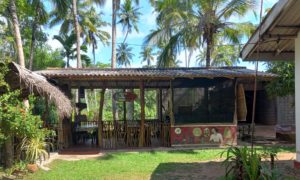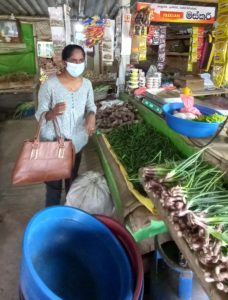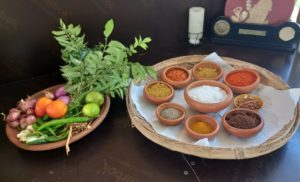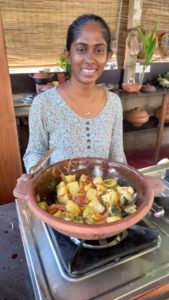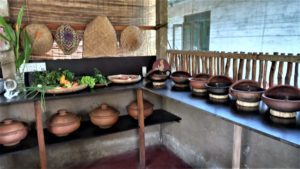Early in our trip to Sri Lanka, we arranged a cookery lesson to help us understand the country’s cuisine and, hopefully provide ideas for recreating dishes back at home.
Our lesson took place at the Angara Home cooking school, just outside Galle. Dinesha has been running lessons from her home for four years but, like many other businesses, it’s been badly affected by Covid.
On arrival, the three of us squeezed into a tuk tuk for the short drive to a roadside shop where Dinesha introduced us to vegetables both familiar (carrots, beetroot, tomatoes etc) and those less familiar, including bitter and snake gourds.
Back in the spacious covered, outdoor kitchen in the garden, we sipped chilled pineapple juice whilst Dinesha arranged her ingredients, before talking us through her spices – chilli powder, chilli flakes, curry powder, black pepper, turmeric, salt, fenugreek – as well as her basket containing garlic, shallots (like garlic cloves but red), onions, cinnamon, limes, tomatoes, curry leaves, pandan leaves (also known as rampe), thin green chillies and ginger.
Sri Lanka’s main dish is simply known as ‘rice and curry’ but comprises of several small bowls of vegetarian curries and generally either one of meat or fish. This meal is found in road side cafes as well as smart restaurants and this is what we were going to create and eat.
The first task was to prepare the rice by washing it vigorously three times in cold water before straining it through cupped fingers. This is when we began to realise that many of the gadgets we have in our kitchen at home, are actually superfluous as apart from a measuring teaspoon, nothing was weighed. Spices and water, up to the second knuckle above the rice, were added and the pan put on one of two ring burners we used to cook the entire meal. Once the water was absorbed, the rice was left to stand for 10 minutes before being stirred.
We then began cooking individual curries featuring potatoes, aubergines, American oyster mushrooms, green beans, dahl and prawns. All the food was cooked in traditional clay pots which are said to produce the best curries. This was a hands-on course and we sliced shallots, chopped chillies, prepared pandan leaves, bruised curry leaves and stirred in what we thought were somewhat alarming volumes of salt and spices.
As each dish was completed, the pot was placed in line to create a buffet. Once we’d finished, the table was simply set, and we were invited to help ourselves. My favourite dishes were the aubergine and potato curries which were so full of flavour and spicy. It was therefore good to finish with a pre-prepared pudding of Watalappan, a cooling creamy coconut custard.
The whole experience was authentic and informal with Dinesha’s two small children playing happily nearby with their toys. Hopefully as tourism picks up following the Covid pandemic, so will Dinesha’s cooking school.
